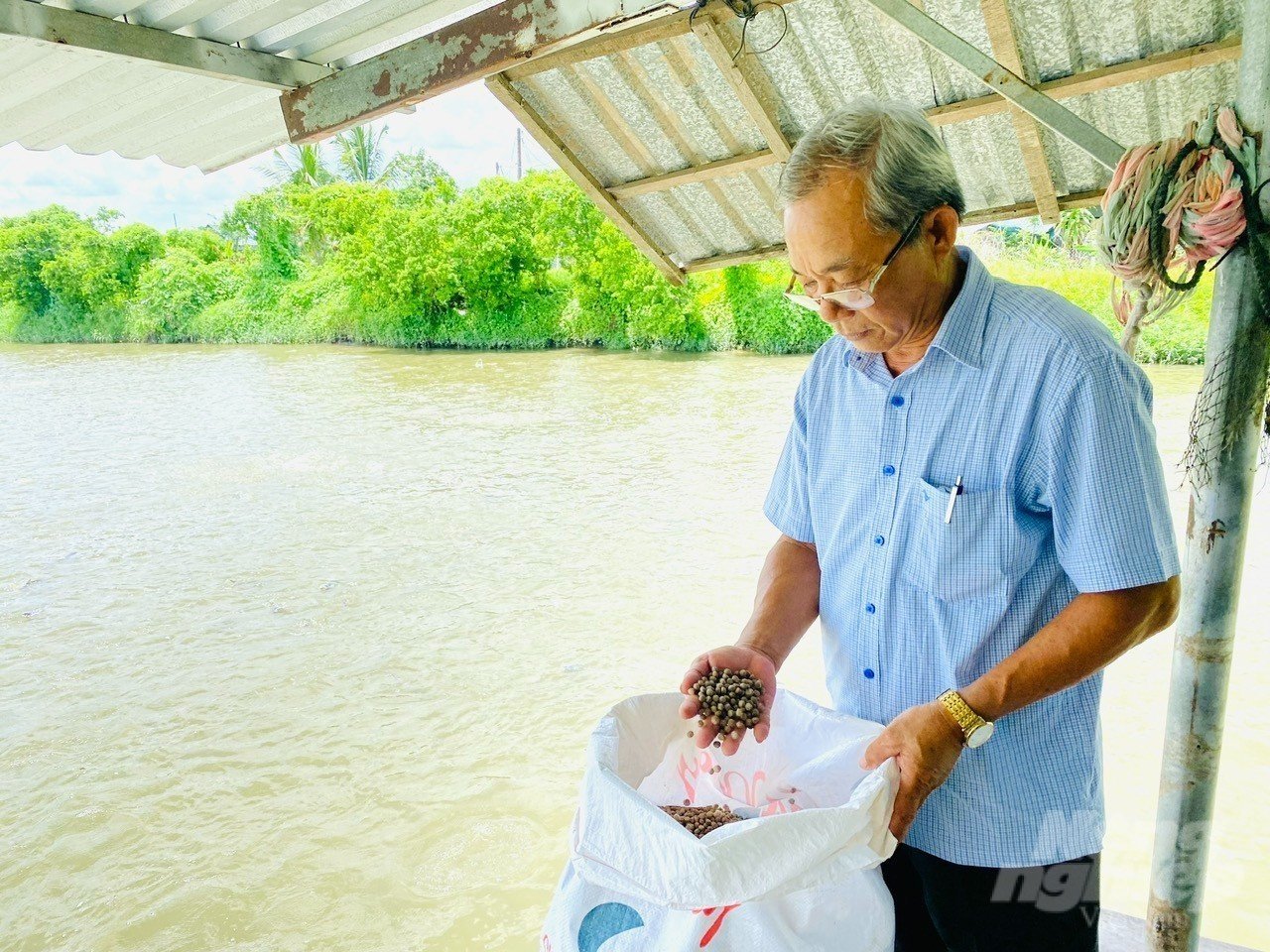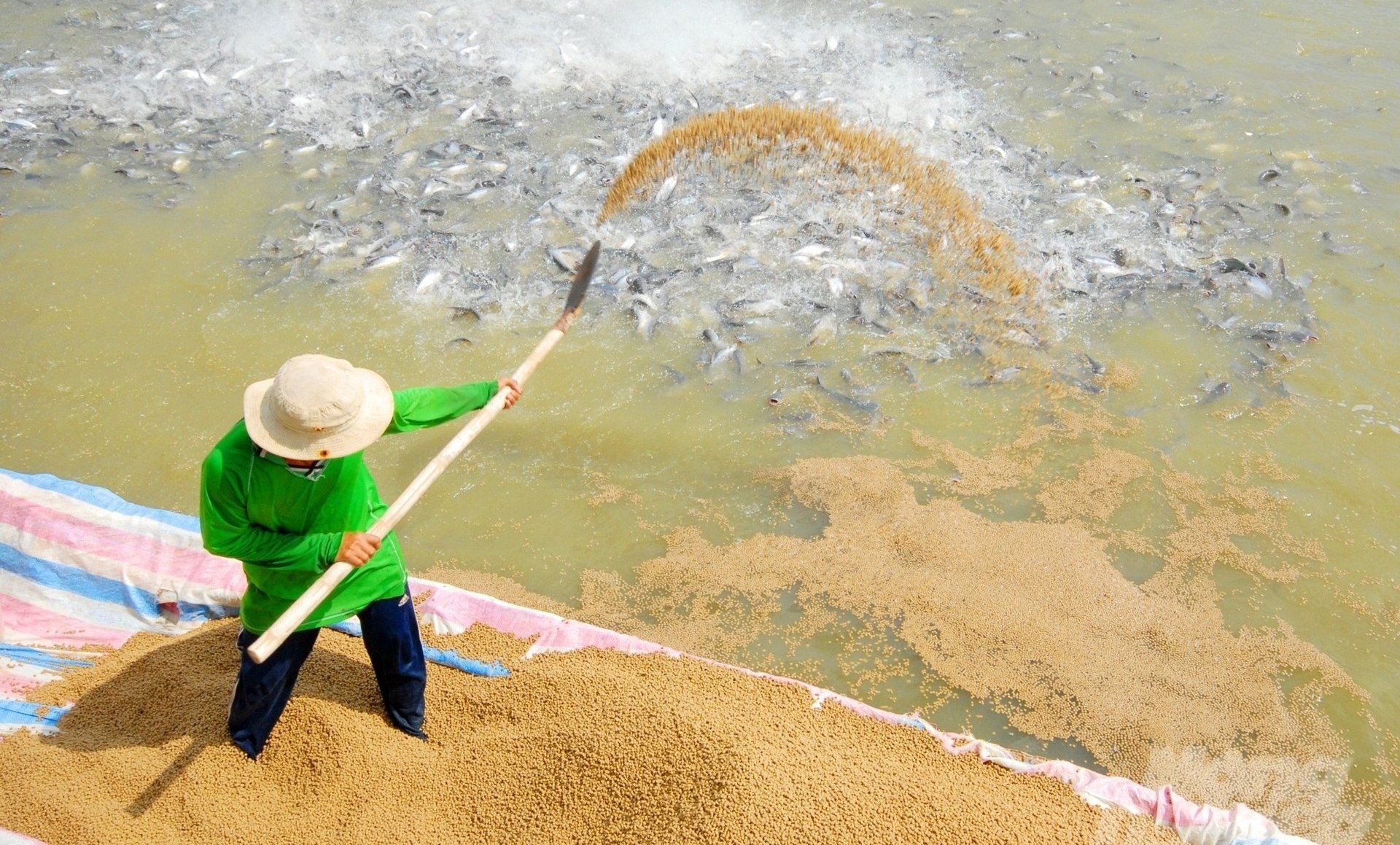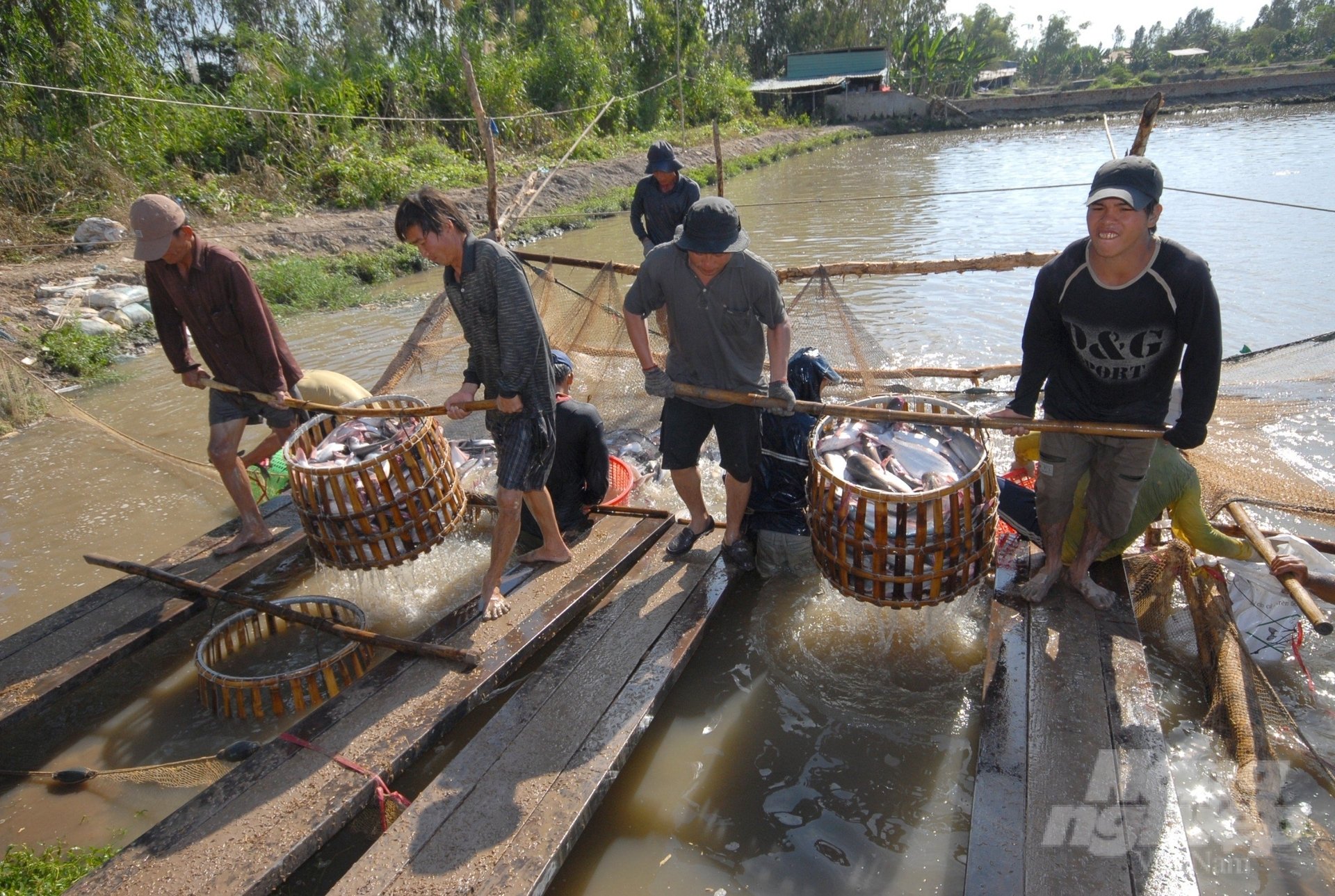May 31, 2025 | 07:07 GMT +7
May 31, 2025 | 07:07 GMT +7
Hotline: 0913.378.918
May 31, 2025 | 07:07 GMT +7
Hotline: 0913.378.918

Mr. Nguyen Thanh Binh, Director of Chau Thanh Seafood Service Cooperative, Dong Thap, checks the food. Photo: Le Hoang Vu.
Mr. Nguyen Thanh Binh, Chairman of the Board of Directors and Director of Chau Thanh Seafood Service Cooperative (An Nhon commune, Chau Thanh district, Dong Thap province), the cooperative has just harvested several hundred tons of fish to sell to businesses with a small profit. There are no losses like other pangasius farming households. That's why all cooperative members are excited because the fish price on the market is currently lower than the average farming cost, but the linked chain is still profitable.
To achieve profits when the fishery is in crisis, the Board of Directors of Chau Thanh Fisheries Service Cooperative has broken through to find a new direction. In the years when pangasius prices were still flourishing, the cooperative exported 8,000 - 9,000 tons/year. From 2021 until now, while input material prices have increased continuously, fish prices have dropped sharply below cost, pushing many fish farming households into difficult circumstances.
Chau Thanh Fisheries Service Cooperative was established in June 2015 with 16 official members, a charter capital of VND 800 million, and 30 hectares of water surface for raising pangasius.
The method of linking fish farming in the chain is agreed upon by the parties as follows: Co May Lai Vung Co., Ltd. provides 100% of the fish feed for members until the fish is sold before collecting money, the feed price is calculated according to "The price is equal to the price for level 1 agents and a 6% discount on the total purchase value", members who have cash to pay to Co May Lai Vung company will have an additional VND500/kg discount on the order. (If a member borrows from the bank and pays cash to buy food, the discount is VND 500/kg, which is still more profitable than the bank's interest payment).
In addition, the company also sends fisheries engineers to support the cooperative at any time, helping members control water source diseases and decide when to use antibiotics for fish. During the season, Co May Lai Vung Company buys about 50-60% of the fish output at market prices, and the rest of the company finds businesses and traders to buy all of, which companies and traders are not yet assured of. Co May Lai Vung Company guarantees payment if the fish purchasing business does not pay the cooperative after 7-15 days. The profit for the cooperative is 1% of the total of all cash payments of cooperative members.

Members of Chau Thanh Seafood Service Cooperative are supported 100% of the food by Co May Lai Vung Co., Ltd. for the entire farming season. Only after selling the fish will the business receive the food money back. Photo: Le Hoang Vu.
Mr. Binh analyzed that members do not want to leave once members join the cooperative because there are too many benefits in the pangasius farming chain associated with the enterprise.
The first benefit is that the food price is equal to the price the company sells to level 1 agents, plus a discount of 6% of the total invoice value when paying, and if you pay in cash, you will receive an additional direct discount of 500 VND/kg.
The second benefit is that members reduce the pressure to invest capital to buy food (accounting for 60-65% of production costs).
Thirdly, the cooperative receives a 1% discount from Co May Lai Vung Company on the total food purchased by members. Each year, Chau Thanh Fisheries Service Cooperative guarantees members 6,000 - 7,000 tons of food. The average price of 1kg of pangasius food is currently VND 14,000, so each year, the cooperative receives a discount of about VND 980 million.

Members of the cooperative raise pangasius fish using 100% Co May's feed. Photo: Le Hoang Vu
The fourth benefit is that the cooperative also mobilizes members' capital and uses the VND 2-3 billion cooperative fund to support members who need money urgently to manage the bank maturity within 3-5 days. The member pays returned to the cooperative without interest when the maturity date is complete. All members are supported by the cooperative and other members when the bank matures, so they do not have to use "bank maturity" services with very high costs.
Chau Thanh district has 250 hectares of pangasius farming, specifically in An Nhon islet, An Hoa commune. There are up to 1,500 hectares of agricultural land, including nearly 200 hectares of pangasius farming.
Currently, pangasius farmers in the Mekong Delta are mainly at a loss. Because the investment cost for 1kg of fish is currently up to about VND 28,000 - VND 29,000/kg while the selling price of fish is below cost, only VND 27,000 - VND 27,500/kg, farmers are losing more than 1,000 VND/kg. But Chau Thanh Seafood Service Cooperative members can still survive, despite low profit.
Thanks to cooperatives, there is a way to do business in a chain of businesses to benefit both sides. Typically, pangasius farming households in cooperatives that sell fish at this time are all profitable, such as households of Mr. Nguyen Cong Chanh, Le Dinh Chau, Vo Van Thanh, Le Van Tien...

Mr. Binh analyzed that members do not want to leave once members join the cooperative because there are too many benefits in the pangasius farming chain associated with the enterprise. Photo: Le Hoang Vu.
Mr. Nguyen Van Vu Minh, Director of the Department of Agriculture and Rural Development of Dong Thap province, said that the pangasius industry is one of five industries in Dong Thap's agricultural restructuring. Currently, the province has formed specialized concentrated production areas on a large scale in Thanh Binh, Tam Nong, Tan Hong, Chau Thanh, and Cao Lanh districts. It has issued identification of production unit codes with nearly 100% of commercial pangasius farming areas, of which 60% meet VietGAP, GlobalGAP, and ASC standards. The government and agricultural sector of Dong Thap province have policies to support and encourage pangasius farming households to participate in cooperatives and do collective economic activities to create sustainable value chains.
According to Dr. Tran Minh Hai, the sustainable principles of operating the "shared purchasing" service in cooperatives are: (1) The shared purchasing price is the lowest price and members of the cooperative receive the full benefit. (2) The cooperative will negotiate to receive discounts for management and operations in the chain from businesses selling inputs to the cooperative. Principles for distributing sustainable discount money: a) The cooperative takes 30% to pay for marketing and sales costs. Anyone who helps the cooperative sell more products will receive 30% of this money; b) The cooperative takes the next 30% to pay salaries to the board of directors and the board of directors who directly participate in this shared purchasing service; and c) Finally, about 40% of the remaining cooperative is allocated to the cooperative's common funds and spent on members.
Translated by Tuan Huy

(VAN) Several scientists and farmers are experimenting with soil treatment in some key durian-growing regions such as Cai Lay (Tien Giang), Dak Song, Gia Nghia, and Dak R’lap (Dak Nong).
/2025/05/25/4127-3-073637_820.jpg)
(VAN) Thanks to the promotion from an FAO-implemented project, vegetable production in greenhouses in Moc Chau has seen strong development, from 1.5 hectares in 2021 to nearly 50 hectares in 2024.

(VAN) FAO has recently supported USD 140,000 to implement the project 'Risk mitigation human-animal interface risks through disease control initiatives in pig farming.'

(VAN) The People's Committee of Tra Vinh province has approved an adjustment to the investment policy for the Green Hydrogen Plant project, increasing its area to approximately 52.76 hectares.
![Reducing emissions from rice fields: [2] Farmers’ commitment to the soil](https://t.ex-cdn.com/nongnghiepmoitruong.vn/608w/files/news/2025/05/05/dsc08881jpg-nongnghiep-140632.jpg)
(VAN) Clean rice cultivation model in Thuong Tan commune, Bac Tan Uyen district, is assisting local residents in achieving sustainable agriculture by substantially reducing costs, increasing productivity, and protecting the environment.

(VAN) At the conference to disseminate Resolution No. 68, AgriS introduced its digital agricultural ecosystem and reaffirmed its commitment to accompanying the Government in promoting private sector development and sustainable agriculture.

(VAN) 'Blue Ocean - Blue Foods' initiative is designed to restore marine ecosystems and establish sustainable livelihoods for local communities by cultivating a minimum of 1,000 hectares of cottonii seaweed in the first three years.